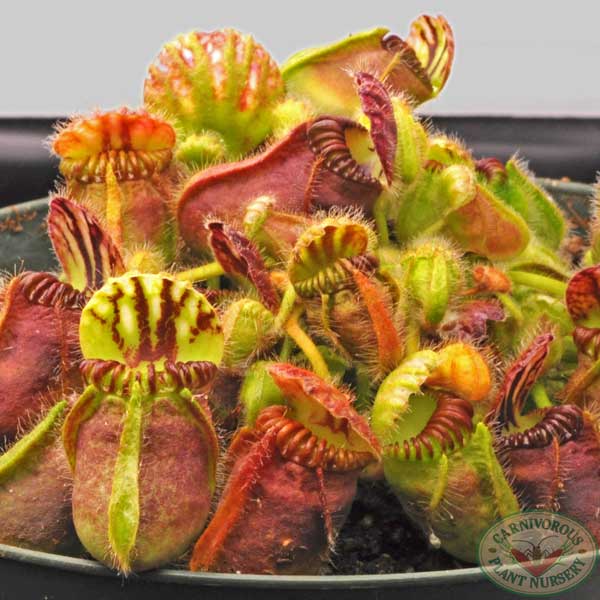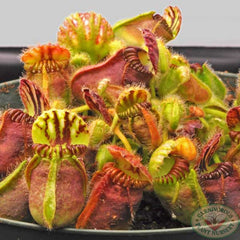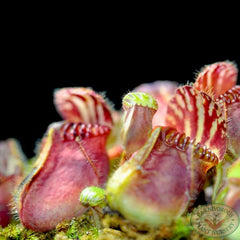
Growing Tips for Cephalotus



Western Australian Pitcher Plant - Cephalotus follicularis.
Soil: 2:1:1:1/2:1 sand:peat:perlite:fir bark:leaf mould mix
Container: 4+" plastic pot
Watering: consistently moist, not wet
Light: full to part sun, seasonal change
Temperature: moderate year round, cool nights, seasonal and daily change-tolerates frost
Humidity: medium
Location: windowsill, terrarium, greenhouse, outdoors
Dormancy: yes
Habitat
The Western Australian Pitcher Plant, Cephalotus follicularis, grows naturally in the peat of spring-fed swamps of southwestern Australia near Albany. It grows along the grassy edges of the coastal heathlands, where the moist soil is typically a sand/peat mix, often sandier than peaty. The climate is mediterranean, with fairly constant temperatures year round including warm days, and cool nights. The mean summer temperature is 68°F (20°C) and the mean winter temperature is 53°F (12°C) with temperature ranges between 32-113°F (0-45°C). Rainfall is about 1”/month (2.5cm) in the summer and 5”/month (13cm) in the winter. Companion Carnivorous Plants include Drosera hamiltonii, D. pulchella, D. binata T-form, D. menziesii, and several varieties of Utricularia such as U. simplex and U. multifida.
Culture
The Western Australian Pitcher Plant is challenging to grow. It does not like extended heat and is prone to root rot. It may appear to “suddenly” die if kept too hot or wet. It prefers deep, well-drained, evenly moist soil. A Carnivorous Plant soil mix of 2 parts peat, 1 part each of sand, perlite, leaf mould and 1/2 fir bark works well. Plant in a deep 4-6” (10-15cm) pot that drains well. It does not like having its roots disturbed, and seems to grow best when pot-bound. Water with mineral-free water, keeping the soil evenly moist, but not soaking wet for summer, and drier, but still damp in winter. If using the tray method, be sure to let the tray dry out between watering. Cephalotus prefers filtered bright, sunny conditions at normal room temperatures. Avoid very hot conditions for prolonged periods. Allow it to rest in the winter, when it may go dormant. They get their best color in bright light, and largest traps after dormancy.
Dormancy
A winter rest period is normal for mature plants. As day length and temperature diminish the plant will slow its growth and may die back. Reduce watering in the winter and allow the tray to become dry in between watering, but keep the soil evenly moist. Provide slightly cooler temperatures in the winter, but remember it comes from a mediterranean habitat and prefers moderate temperatures year round. Cephalotus can tolerate light frost and brief temperatures as low as 22°F (-5°C).
Feeding
During the active growth of Spring and Summer feed using wingless fruit flies, ants or other small insects. The food does not have to be alive.
Other Considerations
Cephalotus does best when provided with diurnal (daily) and seasonal light and temperature changes. Good air circulation is helpful. Consider growing outdoors in summer and indoors in winter.
Cephalotus is an ideal Carnivorous Plant for a terrarium. Its low growth habit allows fluorescent lights to be brought near to the plants. The lights should be about 6” from the plants, and on a timer set for 16 hours/day. Considering mimicking the natural change in daylength, by adjusting the timer seasonally (spring:summer:fall:winter to 12:14:12:10 hrs). Remember to keep the terrarium vented and the soil moist, but not waterlogged. Plant in deep soil.
Keep the crown of the plant dry. Use a soil top dressing of sand to promote this.
Cephalotus does not like having its roots disturbed.
It is generally a good idea to remove the flower spike when it forms. If left to grow, it draws energy from the plant and can weaken a potted plant to the point of death. Seed formation requires flowers from separate plants.
Cephalotus can be tricky to grow. It is prone to “sudden death syndrome,” which is usually the result of unseen root rot from soil too damp and not properly aerated, or prolonged high temperatures. Do not discard a seemingly dead plant. Often Cephalotus will send up new growth from it rhizomes. This may take several months. Be patient.
Propagation from leaf, trap, or root cuttings can be done early in the growing season. Use a rooting hormone and cover the cutting with a clear cup or other similar device to keep the humidity high. Place in warm, bright light. Expect few successes, but enjoy each one.
Cephalotus is very popular and in high demand by hobbyists. Because it is slow to grow and difficult to propagate, it is often very expensive compared to other Carnivorous Plants.
